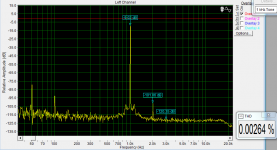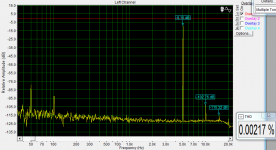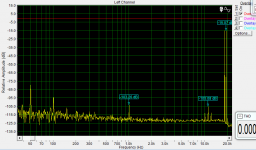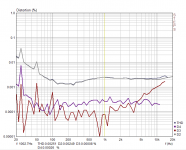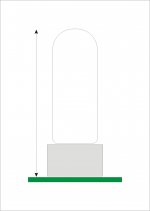Terry
I am happy to see it is working. It is very simple and basic amp (classic). I like it too.
Clipp is nice and not sticking, squares looks good too. I am going to add one 100pF cap just in case because of input tupe tolerances (they all are not the same).
Hi Borys,
I've had the amp playing for hours now. Absolutely no issues so far. I have it hooked up to my A/B setup and compared it to a few amps. It is almost indistinguishable from my PMI VSSA. It has better highs than the SKA GB150. I don't find it lacking in bass at all. Very glad I built it. I will recommend it folks who are looking to do a hybrid. Very few parts and all easily obtainable. Easy board to etch. Now I need to get your little OPS working. 😉
You say you are planning to add a 100p cap. Where does that go?
Thanks, Terry
Terry
I plan to putt the 100pF or a bit lower value in parallel to the 100kR VAS load resistor - just in case (tube tolerances) but If someone have a scope and test the squares, there is no need to install it at all.
The OPS --> just putt the jumpers in place of the three resistors mentioned before and use 10R base stoppers (OP transistors) instead of 4,7R, from my measurements it looks better than with 4,7R.
Marc
I will send you email with files.
I plan to putt the 100pF or a bit lower value in parallel to the 100kR VAS load resistor - just in case (tube tolerances) but If someone have a scope and test the squares, there is no need to install it at all.
The OPS --> just putt the jumpers in place of the three resistors mentioned before and use 10R base stoppers (OP transistors) instead of 4,7R, from my measurements it looks better than with 4,7R.
Marc
I will send you email with files.
Last edited:
Marc
I will send you email with files.
Bellow V3 a bit updated version (I slowered it down).
Thanks Borys
Marc
I will test 4 differed tubes tomorrow and chose some more optimal values, I will post it tomorrow.
I will test 4 differed tubes tomorrow and chose some more optimal values, I will post it tomorrow.
Marc
I will test 4 differed tubes tomorrow and chose some more optimal values, I will post it tomorrow.
OK i stay tune...
Marc
Interesting application of tube to a Hitachi 1972 AN........ I saw this done a few years back with an Italian circuit. This is a global nfb design, but with a thermionic twist, I too would be interested to hear how it sounds. After all, topology largely drives the 'sound' of an amplifier.... regardless of feedback in any way.
I take my hat off to Peter, and to Terry, who seems to be quite capable of building amp in his sleep.......
Hugh
I take my hat off to Peter, and to Terry, who seems to be quite capable of building amp in his sleep.......
Hugh
Hi Hugh,
It sounds very nice and is quite quick to settle which surprised me. The other Hybrids I have built don't settle this quickly. I'm playing it through a small OPS right now with just one pair of LFETs. In the next couple of days I hope to attach it to a big OPS and see how it sounds with some power behind it.
Borys,
I got your OPS working today with the newer layout. I didn't change the base stoppers but I did install the 100p caps on the drivers. It works flawlessly. I then tried installing the 100p caps on the earlier boards and the bias jump is still there. Very strange. I'm just going to etch another board with the newer layout and transfer parts over and see how that goes. So strange that your boards work fine with the original layout and mine won't. I'd love to find out why.
Blessings, Terry
It sounds very nice and is quite quick to settle which surprised me. The other Hybrids I have built don't settle this quickly. I'm playing it through a small OPS right now with just one pair of LFETs. In the next couple of days I hope to attach it to a big OPS and see how it sounds with some power behind it.
Borys,
I got your OPS working today with the newer layout. I didn't change the base stoppers but I did install the 100p caps on the drivers. It works flawlessly. I then tried installing the 100p caps on the earlier boards and the bias jump is still there. Very strange. I'm just going to etch another board with the newer layout and transfer parts over and see how that goes. So strange that your boards work fine with the original layout and mine won't. I'd love to find out why.
Blessings, Terry
Terry
I have new 2 layer layout, I have measured THD on all of them and the dual layer outperforms all of them (I did around 30-50 measurement test all together).
It is nasty to solder but is THD killer.
And funny thing is on my board I do not have the 100pF at the drivers installed and all 3 boards work fine.
It is strange - so strange that If I am not sleeping I am thinking why is that board not working.
The VSHA_Classic now.
I have installed a few tubes today, I think You can make a small change:
1. increase compensation cap 10pF to 15pF or change resistors values in NFB network from 22k/470 to 33k/680
2. If You would like to have symmetric square waves --> replace 47R VAS resistor with 100R (than negative and positive slev will be the same).
Hugh
There is no time for sleeping 🙂
In my opinion Hitachi VAS have something magnetic, lots of details in background (tube is helping here too). There are two VSHA versions, HD with Hitachi vas and Classic (Terry have it) with simpe transistor and ccs vas. I am surprised the simple version is performing so well at the top octave (H2 is dominating threw all audio band in roughly the same quantity).
Terrys version measured bellow .
I have new 2 layer layout, I have measured THD on all of them and the dual layer outperforms all of them (I did around 30-50 measurement test all together).
It is nasty to solder but is THD killer.
And funny thing is on my board I do not have the 100pF at the drivers installed and all 3 boards work fine.
It is strange - so strange that If I am not sleeping I am thinking why is that board not working.
The VSHA_Classic now.
I have installed a few tubes today, I think You can make a small change:
1. increase compensation cap 10pF to 15pF or change resistors values in NFB network from 22k/470 to 33k/680
2. If You would like to have symmetric square waves --> replace 47R VAS resistor with 100R (than negative and positive slev will be the same).
Hugh
There is no time for sleeping 🙂
In my opinion Hitachi VAS have something magnetic, lots of details in background (tube is helping here too). There are two VSHA versions, HD with Hitachi vas and Classic (Terry have it) with simpe transistor and ccs vas. I am surprised the simple version is performing so well at the top octave (H2 is dominating threw all audio band in roughly the same quantity).
Terrys version measured bellow .
Attachments
Peter,
Could I suggest that BECAUSE there is higher H2 that the top end is 'sweet'???
The other issue is the tube choice. You have a 12AU7, which is known to like higher voltage. Have you considered a 6DJ8, or a Ruskie high perveance device? These can run very linearly at only 40 Vak, and with a much lower rp, suited to the 3k3 load here.
BTW, high loading with tubes gives you more H2 and H3, reduced of course with high global NFB, but still evident in the distortion profile you showed us.
Bloody good work, Sir, good design.........
Hugh
I am surprised the simple version is performing so well at the top octave (H2 is dominating threw all audio band in roughly the same quantity).
Could I suggest that BECAUSE there is higher H2 that the top end is 'sweet'???
The other issue is the tube choice. You have a 12AU7, which is known to like higher voltage. Have you considered a 6DJ8, or a Ruskie high perveance device? These can run very linearly at only 40 Vak, and with a much lower rp, suited to the 3k3 load here.
BTW, high loading with tubes gives you more H2 and H3, reduced of course with high global NFB, but still evident in the distortion profile you showed us.
Bloody good work, Sir, good design.........
Hugh
Hi borys,
I may try the changes on the classic. I did notice the slightly lower voltage on the negative wave. I don't understand the issue with the first OPS boards either. I have not seen this behavior before and both boards behave the same way. They play perfectly with no load and self destruct as soon as a load is attached. I'm not sure the newer design needs the base stoppers on the drivers. I didn't try it without them. I think I will just build the second board from scratch and save the first pair so I can play around with them later as a study tool.
However it measures, that little Classic sounds very nice I am quite tempted to build a case for it. This is my 4th hybrid. The others were built on professional boards but even with the etching, this one was the easiest to build and the easiest to get playing well. It seems to work on lower voltages too and that is a plus.
Blessings, Terry
I may try the changes on the classic. I did notice the slightly lower voltage on the negative wave. I don't understand the issue with the first OPS boards either. I have not seen this behavior before and both boards behave the same way. They play perfectly with no load and self destruct as soon as a load is attached. I'm not sure the newer design needs the base stoppers on the drivers. I didn't try it without them. I think I will just build the second board from scratch and save the first pair so I can play around with them later as a study tool.
However it measures, that little Classic sounds very nice I am quite tempted to build a case for it. This is my 4th hybrid. The others were built on professional boards but even with the etching, this one was the easiest to build and the easiest to get playing well. It seems to work on lower voltages too and that is a plus.
Blessings, Terry
Terry
I will post U the OPS board layout today evening (in 8-10 hours time).
Hugh
I will try that 6DJ8 tube for sure. Must buy it first and give it a try.
I like simple stuff.
I will post U the OPS board layout today evening (in 8-10 hours time).
Hugh
I will try that 6DJ8 tube for sure. Must buy it first and give it a try.
I like simple stuff.
Hugh
I will try that 6DJ8 tube for sure. Must buy it first and give it a try.
I like simple stuff.
This an option i will follow with attention. I use 6DJ8 for a while in a tube buffered Gainclone (Lm3875). I choose these buffer due the no HT rail need...There are plenty 6DJ8/6922 available even good russian 6N1P at cheap prices.
Marc
Yes there are plenty of 6N1P on ebay too
Marc
Peter,
Could I suggest that BECAUSE there is higher H2 that the top end is 'sweet'???
The other issue is the tube choice. You have a 12AU7, which is known to like higher voltage. Have you considered a 6DJ8, or a Ruskie high perveance device? These can run very linearly at only 40 Vak, and with a much lower rp, suited to the 3k3 load here.
BTW, high loading with tubes gives you more H2 and H3, reduced of course with high global NFB, but still evident in the distortion profile you showed us.
Bloody good work, Sir, good design.........
Hugh
Hi Hugh,
My tests within Low TIM Hybrid and TubSuMo projects have shown good performance of 12AU7 as a small signal input device with at least 25Vak - in the final designs I've got 30Vak in Low TIM and 33Vak in TubSuMo. I like this tube a lot for combination of low noise and high linearity. It would be interesting to test 6DJ8 or the Russian 6Н1П though - thank you for pointing this out 😉
Cheers,
Valery
Hi Borys,
could you mesure the -tube+socket- height from pcb base?
Marc
Mine are 10mm.
Mine are 10mm.
Thanks terry but i for sure don't well explain what i want for mesure as 10mm seems to be a to lo value => see attache draw
Attachments
Thanks terry but i for sure don't well explain what i want for mesure as 10mm seems to be a to lo value => see attache draw
56mm
- Home
- Amplifiers
- Solid State
- Very Simple Hybrid Ampifier
